If you’re preparing for SSC MTS 2025, mastering Coding-Decoding is essential to score well in the reasoning section. This article brings you SSC MTS Important Coding Decoding Questions and Answer tailored for SSC MTS aspirants. These questions cover all common patterns like letter shifting, number coding, substitution, and symbol-based logic, helping you grasp concepts quickly and boost accuracy. Practicing these questions will strengthen your logical thinking and problem-solving speed. As the SSC MTS 2025 exam is scheduled from 20 September to 24 October 2025, now is the perfect time to revise and test yourself with these frequently asked coding-decoding questions. All The Best!
SSC MTS Important Coding Decoding Questions and Answer
Q1. In a certain code language, ‘he enjoys music’ is coded as ‘lo po jo’ and ‘music anddance’ is coded as ‘kb jo fk’. How is ‘music’ coded in the given language?
(A). jo
(B). po
(C). lo
(D). fk
Answer: a
Solution:
From the given code are – 
From the above code of music is jo.
Correct answer is (a).
Q2. In a certain code language, ‘BEDROOM’ is written as ‘28’, and ‘MOON’ is written as ‘16’. How will ‘CHAIN’ be written in that language?
(A). 20
(B). 26
(C). 24
(D). 23
Answer: a
Solution:
Given:
BEDROOM → 28, MOON → 16
CHAIN → ?

Logic: Multiply the number of letters in the given word by 4 to get the respective code.
BEDROOM →28
7 × 4 = 28
MOON → 16
4 × 4 = 16
Similarly,
for CHAIN → ?
5 × 4 = 20
So, CHAIN is written as 20.
Thus, the correct option is option (a).
Q3. In a certain code language, ‘QUITE’ is coded as ‘216’, ‘PROVE’ is coded as ‘228’. What is the code for ‘EXIST’ in that code language?
(A). 258
(B). 252
(C). 231
(D). 256
Answer: c
Solution:
Given:
‘QUITE’ is coded as ‘216’
‘PROVE’ is coded as ‘228’
Logic: Sum of positional value of the letter multiply by 3.
For “QUITE” → 216:
Sum of positional values:
17+21+9+20+5=72
Multiply by 3:
72×3=216
For “PROVE” → 228:
Sum of positional values:
16+18+15+22+5=76
Multiply by 3:
76×3=228
For “EXIST”:
Sum of positional values:
5+24+9+19+20=77
Multiply by 3:
77×3=231
Correct answer is (c) 231.
Q4. In a certain code language, TRUST is written as UTXWY and GROUP is written as HTRYU. How will VISIT be written in that language?
(A). WKUNZ
(B). XKUNY
(C). WKVMY
(D). WLUNY
Answer: c
Solution:
Given:
TRUST → UTXWY
GROUP → HTRYU
Logic: Each letter is increased by 1, 2, 3, 4, 5 respectively
TRUST → UTXWY
T → U (+1)
R → T (+2)
U → X (+3)
S → W (+4)
T → Y (+5)
GROUP → HTRYU
G → H (+1)
R → T (+2)
O → R (+3)
U → Y (+4)
P → U (+5)
Apply to VISIT
V → W (+1)
I → K (+2)
S → V (+3)
I → M (+4)
T → Y (+5)
So, VISIT → WKVMY
Correct answer: (C) WKVMY
Q5. In a certain code language, ‘time and again’ is coded as ‘zx df mo’ and ‘value your time’ is coded as ‘df pn tv’. How is ‘time’ coded in the given language?
(A). mo
(B). df
(C). tv
(D). zx
Answer: b
Solution:
Given:
‘time and again’ is coded as ‘zx df mo’
‘value your time’ is coded as ‘df pn tv’.
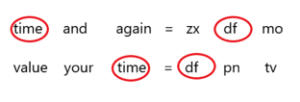
From the above the code of time will be df.
Correct answer is (b). df
Q6. In a certain code language, ‘SOAP’ is coded as 4629′ and ‘SPOT’ is coded as ‘9824″. How is ‘A’ coded in the given language?
(A). 4
(B). 2
(C). 8
(D). 6
Answer: d
Solution:
Given words and their codes:
SOAP → 4629
SPOT → 9824
From the above in both SOP is common and in the code 429 is common.
Thus, from SOAP → 4629 the code of A will be 6
Correct answer is (d).
Q7. In a certain code language, ‘RIVAL’ is coded as ‘PKTCJ’ and ‘TEXTS’ is coded as ‘RGVVQ’. How will ‘POINT’ be coded in thegiven language?
(A). NRGOR
(B). OQGPO
(C). NQGPR
(D). OQGOQ
Answer: c
Solution:
Logic: Pattern: -2, +2, -2, +2, -2
RIVAL → PKTCJ
R → P (-2)
I → K (+2)
V → T (-2)
A → C (+2)
L → J (-2)
TEXTS → RGVVQ
T → R (-2)
E → G (+2)
X → V (-2)
T → V (+2)
S → Q (-2)
Apply the same pattern to “POINT”
P → N (-2)
O → Q (+2)
I → G (-2)
N → P (+2)
T → R (-2)
Thus, POINT → NQGPR.
Correct answer is (C) NQGPR
Q8. JNLO is related to ILIK in a certain way based on the English alphabetical order. In the same way, NRPS is related to MPMO. To which of the following is LPNQ related, following the same logic?
(A). KMKN
(B). KNKM
(C). KOKM
(D). KMKO
Answer: b
Solution:
Given:
JNLO is related to ILIK
NRPS is related to MPMO
JNLO to ILIK
J to I : J(10) -1 = I(9)
N to L: N(14) -2 =L(12)
L to I : L(12) – 3 = I(9)
O to K : O(15) – 4 = K(11)
NRPS to MPMO
N to M : N(14)-1= M(13)
R to P : R(18) -2= P(16)
P to M : P(16) -3=M(13)
S to O : S(19) – 4 =O(15)
Now, let’s apply the same pattern to LPNQ
L to K: L (12) – 1 = K (11)
P to N: P (16) – 2 = N (14)
N to K: N (14) – 3 = K (11)
Q to M: Q (17) – 4 = M (13)
So, ‘LPNQ’ is coded as KNKM
Q9. In a certain code language, ‘INDULGE’ is coded as ’48’ and ‘PURGE’ is coded as ’24’. How will ‘PUNY’ be coded in that language?
(A). 25
(B). 20
(C). 18
(D). 15
Answer: d
Solution:
Logic: Square of the number of letters in the word and then subtracting 1 to determine the code.
Given Examples:
INDULGE: Number of letters = 7
72−1=49−1=48
This matches the given code for ‘INDULGE’.
PURGE: Number of letters = 5
52−1=25−1=24
This matches the given code for ‘PURGE’.
Applying the Logic to ‘PUNY’:
PUNY: Number of letters = 4
42−1=16−1=15
So, according to the logic provided, the code for ‘PUNY’ is 15.
Therefore, the answer is: (d) 15.
Q10. In a certain code language, ‘MENIAL’ is coded as ‘NIEAML’ and ‘INCOME’ is coded as ‘CONMIE’. What is the code for ‘FOREGO’ in the given code language?
(A). OFOREG
(B). FOGERO
(C). OGEROF
(D). REOGFO
Answer: d
Solution:
Given: ‘MENIAL’ is coded as ‘NIEAML’ and ‘INCOME’ is coded as ‘CONMIE’ Observe the pattern in the given examples:
Combination of pairs of two letters are are shifting like following:

Correct answer is (d) REOGFO
Q11. In a certain code language, ‘MUTUAL’ is written as ‘12121202113’, ‘MARKET’ is written as ‘2051118113’, how will ‘MODULE’ bewritten in that language?
(A). 1315421125
(B). 5122141513
(C). 5122141613
(D). 14122361522
Answer: b
Solution:
Given:
‘MUTUAL’ is written as ‘12121202113’,
‘MARKET’ is written as ‘2051118113’
In this question following pattern is followed –

Correct answer is (b)
Q12. In a certain code language, ‘pleased to meet’ is written as ‘bj sc vw’ and ‘meet and greet’ is written as ‘ih bj tf’. How is ‘meet’ written in the given language?
(A). vw
(B). tf
(C). bj
(D). ih
Answer: c
Solution:
We are given the coded words:
‘pleased to meet’ → ‘bj sc vw’
‘meet and greet’ → ‘ih bj tf’
The word ‘meet’ appears in both phrases.
The common code in both coded phrases is ‘bj’.
Since ‘meet’ is the only common word in both phrases, the code for ‘meet’ must be ‘bj’.
Correct answer is (C) bj
Q13. RTVX is related to SUWY in a certain way based on the English alphabetical order. In the same way, KMOQ is related to LNPR. To which of the following is FHJL related, following the same logic?
(A). GIKM
(B). GHJK
(C). GIJK
(D). GIKN
Answer: a
Solution:
Let’s analyze the given pattern:
RTVX → SUWY
KMOQ → LNPR

Logic: The pattern is each letter shifts forward by +1.
Observing the letter shifts:
R → S (+1)
T → U (+1)
V → W (+1)
X → Y (+1)And
K → L (+1)
M → N (+1)
O → P (+1)
Q → R (+1)
Applying the same pattern to FHJL:
F → G (+1)
H → I (+1)
J → K (+1)
L → M (+1)
Thus, FHJL → GIKM.
Correct answer: (A) GIKM
Q14. In a certain code language, ‘YOUNG’ is coded as ‘25796’, ‘WOULD’ is coded as ‘80532’, ‘CANDY’ is coded as ‘49163′. What can be the code for ‘Y’ in that code language?
(A). 7
(B). 2
(C). 9
(D). 5
Answer: c
Solution:
The given codes:
· ‘YOUNG’ is coded as ‘25796’.
· ‘WOULD’ is coded as ‘80532’.
· ‘CANDY’ is coded as ‘49163’.
In the codes provided, we observe:
The letter ‘Y’ appears in both ‘YOUNG’ and ‘CANDY’.
· In ‘YOUNG’, ‘Y’ is coded as ‘9’ and ‘6’
· In ‘CANDY’, ‘Y’ is coded as ‘9’ and ‘6’.
In the given option 6 is not available.
Therefore, the code for ‘Y’ in this code language is 9.
Q15. In a certain code language, if BRINJAL is coded as ZPKLHCJ, TOMATO is coded as RQKCRQ, then what will STRAWBERRY be coded as?
(A). WPPGZUCPRQ
(B). KOIURYETWQ
(C). QWTEYRUIOK
(D). QRPCUZGPPW
Answer: d
Solution:
Logic: Consonants – 2 and vowels + 2
BRINJAL → ZPKLHCJ
Subtracting 2 from B,R,N,J,L and Add 2 in I,A:
B → Z, R → P, I → K, N → L, J → H, A → C, L → J
TOMATO → RQKCRQ
Subtracting 2 from T, M, T, And Add 2 in O, A, O:
T → R, O → Q, M → K, A → C, T → R, O → Q
Now for STRAWBERRY:
Subtracting 2 from S, T, R, W, B, R, R, Y And Add 2 in A, E
S → Q, T → R, R → P, A → C, W → U, B → Z, E → G, R → P, R → P, Y → W
Code for STRAWBERRY: QRPCUZGPPW
Correct answer is (d) QRPCUZGPPW
Q16. In a certain code language, ‘FEAR’ is coded as ‘JJEW’. What is the code for ‘FLAT’ in that code language?
(A). JQEY
(B). JQDY
(C). JREZ
(D). JQEZ
Answer: a
Solution:
Given:
‘FEAR’ is coded as ‘JJEW’

- F → J (Shift of +4)
· E → J (Shift of +5)
· A → E (Shift of +4)
· R → W (Shift of +5)
It appears that the letters alternate between a shift of +4 and +5.
let’s apply it to each letter in “FLAT”:
· F → J (Shift of +4)
· L → Q (Shift of +5)
· A → E (Shift of +4)
· T → Y (Shift of +5)
Thus, the code for “FLAT” is JQEY.
Correct answer is (a) JQEY.
Q17. ‘ETHICS’ is related to ‘AVDKYU’ in a certain way based on the English alphabetical order. In the same way, ‘CUSTOM’ is related to ‘YWOVKO’. To which of the following is ‘PRINCIPLES’ related, following the same logic?
(A). LSEPYKLNAU
(B). LTEPYKLNAU
(C). LTFPYKLNAU
(D). LTEPYKLMAU
Answer: b
Solution:
Logic: 1st letter decreased by -4 and 2nd letter increased by +2 respectively and so on.
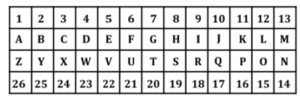
“ETHICS” → “AVDKYU”
E → A (Shift back by 4)
T → V (Shift forward by 2)
H → D (Shift back by 4)
I → K (Shift forward by 2)
C → Y (Shift back by 4)
S → U (Shift forward by 2)
So, the pattern alternates: (-4, +2, -4, +2, -4, +2)
Step 2: Verify with “CUSTOM” → “YWOVKO”
C → Y (-4)
U → W (+2)
S → O (-4)
T → V (+2)
O → K (-4)
M → O (+2)
The pattern holds: (-4, +2, -4, +2, -4, +2)
Step 3: Apply the same pattern to “PRINCIPLES”
P → L (-4)
R → T (+2)
I → E (-4)
N → P (+2)
C → Y (-4)
I → K (+2)
P → L (-4)
L → N (+2)
E → A (-4)
S → U (+2)
Thus, “PRINCIPLES” transforms to LTEPYKLNAU.
Thus, the correct answer is: (b) LTEPYKLNAU
Q18. In a certain code language, ‘COKE’ is coded as ‘1357’ and ‘JOKE’ is coded as ‘5673’. What is the code for ‘J’ in the given code language?
(A). 5
(B). 6
(C). 7
(D). 3
Answer: b
Solution:
Given:
COKE →\rightarrow→ 1357
JOKE →\rightarrow→ 5673

O, K and E and the code 3, 5 and 7 is common.
Now, the code for the J will be 6.
Thus, the correct option is (b) 6.
Q19. In a certain code language, ‘BILLION’ is coded as ‘3264581’ and ‘MILLION’ is coded as ‘3249581’. What is the code for ‘M’ in that language?
(A). 6
(B). 9
(C). 3
(D). 5
Answer: b
Solution:
Given:
‘BILLION’ → ‘3264581’
‘MILLION’ → ‘3249581’
We need to find the code for ‘M’.
Observe the pattern:
The coding sequence corresponds to the position of letters in the words.
The sequence of letters in ‘BILLION’ maps to the numbers 3 2 6 4 5 8 1.
The sequence of letters in ‘MILLION’ maps to the numbers 3 2 4 9 5 8 1.
Compare both words:
Both words share ILLION in common.
In ‘BILLION’, the code for ILLION is 2 3 4 5 8 1.
In ‘MILLION’, the code for ILLION is 2 4 3 5 8 1.
Isolate the unique letter:
The unique letter in ‘MILLION’ is M, which does not appear in ‘BILLION’.
From the code ‘3249581’, the unique number is 9 (as the other numbers match the pattern of ILLION).
Final Answer: The code for ‘M’ is 9.
Q20. In the following question, select the related letter pair from the given alternatives.
DHKL: CGJK :: ?
(A). NUWX: RUCN
(B). ZUZY: ABOD
(C). FXYI: EWXH
(D). TXZW: RULM
Answer: c
Solution:
Compare each letter in DHKL to CGJK:

- D → C: Shifted by -1
· H → G: Shifted by -1
· K → J: Shifted by -1
· L → K: Shifted by -1
Thus, each letter in DHKL is shifted -1 to get CGJK.
Apply the same pattern to find the correct answer among the options.
Option (a) NUWX: RUCN
· N → R: +4
· U → U: 0
· W → C: +6
· X → N: -10
This does not follow the -1 pattern.
(b) ZUZY: ABOD
· Z → A: +1
· U → B: +7
· Z → O: +15
· Y → D: +5
This does not follow the -1 pattern.
Option (c) FXYI: EWXH
· F → E: -1
· X → W: -1
· Y → X: -1
· I → H: -1
This option also matches the pattern.
Thus, the correct answer is (c) FXYI: EWXH.
Q21. In a certain code language, ‘GIVES’ is coded as ‘124’, ‘STEPS’ is coded as ‘158’. What is the code for ‘VIEWS’ in that code language?
(A). 152
(B). 156
(C). 144
(D). 164
Answer: b
Solution:
Given:
‘GIVES’ is coded as ‘124
‘STEPS’ coded as ‘158’
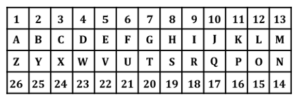
Logic: sum of letter × 2
For “GIVES” → 124:
Sum of alphabet positions:
7+9+22+5+19=62.
62 × 2=124.
For “STEPS” → 158:
Sum of alphabet positions:
19+20+5+16+19=79.
The code 158 is twice the sum of positions:
79 × 2 = 158.
Code for “VIEWS”
Positions of letters in “VIEWS”:
Sum of positions:
22+9+5+23+19=78.
Twice the sum:
78×2=156.
Correct answer: (b) 156
Q22. In a certain code language, ‘now or never’ is coded as ‘ak bj, ut’, and ‘never be late’ is coded as ‘bj tl cv’. How is ‘never’ coded in that language?
(A). cv
(B). bj
(C). ak
(D). tl
Answer: b
Solution:
Given:
“now or never” → “ak bj ut”
“never be late” → “bj tl cv”
The word “never” appears in both phrases:
In “now or never”, the code is “ak bj ut”.
In “never be late”, the code is “bj tl cv”.
The common code in both phrases is “bj”.
Since “never” is the only word common in both sentences, the code for “never” must be “bj”.
Correct answer is (b) bj.
Q23. In a certain code language, ‘CHARGE’ is coded as ‘GHTBJD’. What is the code for ‘CIRCLE’ in that code language?
(A). GMESKD
(B). GEMSKD
(C). GMESKE
(D). GMSEKD
Answer: a
Solution:
In this question following logic is followed –
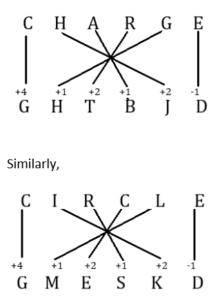
Correct answer is (a).
Q24. In a certain code language, ‘HOST’ is coded as ‘9724’, ‘KINDO’ is coded as ‘45310’, ‘KNOWS’ is coded as ‘37654’. What is the code for ‘W’ in that code language?
(A). 15
(B). 4
(C). 7
(D). 6
Answer: d
Solution:
From the given information-
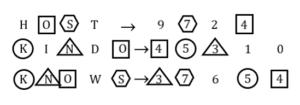
Thus, the code for W is 6.
Correct answer is (d) 6.
Q25. In a certain code language, if SIXTEEN is coded as ’10’, NINE is coded as ‘7’, then what will ‘EIGHT’ be coded as?
(A). 7
(B). 9
(C). 8
(D). 6
Answer: c
Solution:
Logic: The number of letters in the word plus 3.
SIXTEEN has 7 letters.
7 + 3 = 10, so SIXTEEN is coded as 10.
NINE has 4 letters.
4 + 3 = 7, so NINE is coded as 7.
Now, for EIGHT:
EIGHT has 5 letters.
5 + 3 = 8, so EIGHT will be coded as 8.
Correct Answer: (c) 8
Q26. In a certain code language, COMB is coded as 2681 and MOBE is coded as 8163. What is the code of E in that language?
(A). 6
(B). 3
(C). 1
(D). 8
Answer: b
Solution:
Given:
COMB is coded as 2681
MOBE is coded as 8163
In the above coded question MOB is common and in the given code 861 is also common. Thus, the code of E is 3.
Thus, the correct answer is (b) 3.
Q27. In a certain code language, ‘COVER’ is coded as 9-45-66-15-54′ and ‘BOAST’ is coded as 6-45-3-57-60′. What is the code for ‘APRON’ in the given code language?
(A). 2-46-52-40-41
(B). 3-48-54-45-42
(C). 2-46-52-44-40
(D). 4-47-53-42-40
Answer: b
Solution:

Logic: Position of the letter no × 3
First, let’s decode ‘COVER’:
C (3) → 9 (3 × 3 = 9)
O (15) → 45 (15 × 3 = 45)
V (22) → 66 (22 × 3 = 66)
E (5) → 15 (5 ×3 = 15)
R (18) → 54 (18 × 3 = 54)
Next, let’s decode ‘BOAST’:
B (2) → 6 (2 × 3 = 6)
O (15) → 45 (15 × 3 = 45)
A (1) → 3 (1 × 3 = 3)
S (19) → 57 (19 × 3 = 57)
T (20) → 60 (20 × 3 = 60)
It is clear that the code is generated by multiplying the position of each letter in the alphabet by 3.
Now, we apply the same rule to ‘APRON’:
A (1) → 1 × 3 = 3
P (16) → 16 × 3 = 48
R (18) → 18 × 3 = 54
O (15) → 15 × 3 = 45
N (14) → 14 × 3 = 42
So, the code for ‘APRON’ is 3-48-54-45-42.
Therefore, the answer is: (b) 3-48-54-45-42
Q29. HJKN is related to EGHK in a certain way based on the English alphabetical order. In the same way, QSTW is related to NPQT. To which of the following is IKLO related, following the same logic?
(A). FHIL
(B). FHJL
(C). FGIL
(D). FHIK
Answer: a
Solution:
The pattern involves shifting each letter by -3 positions in the alphabet:
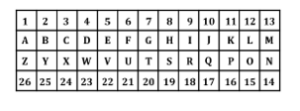
HJKN → EGHK
H → E (Shift backward by 3)
J → G (Shift backward by 3)
K → H (Shift backward by 3)
N → K (Shift backward by 3)
Each letter is shifted backward by 3 positions.
QSTW → NPQT
Q → N (Shift backward by 3)
S → P (Shift backward by 3)
T → Q (Shift backward by 3)
W → T (Shift backward by 3)
Each letter is shifted backward by 3 positions.
Now, applying the same pattern to IKLO:
I → F (Shift backward by 3)
K → H (Shift backward by 3)
L → I (Shift backward by 3)
O → L (Shift backward by 3)
Thus, IKLO → FHIL.
The correct answer is: (a) FHIL.
Q30. In a certain code language, ‘FRAMED’ is coded as ‘497621’ and ‘DREAMT’ is coded as ‘769542’. What is the code for ‘T’ inthat language?
(A). 5
(B). 1
(C). 4
(D). 7
Answer: a
Solution:
Given:
FRAMED → 497621
DREAMT → 769542
In the above code DREAM is common and in the code 76942 is also common. Thus, for DREAMT → 769542 the code of T will be 5.
Correct answer is (a) 5.

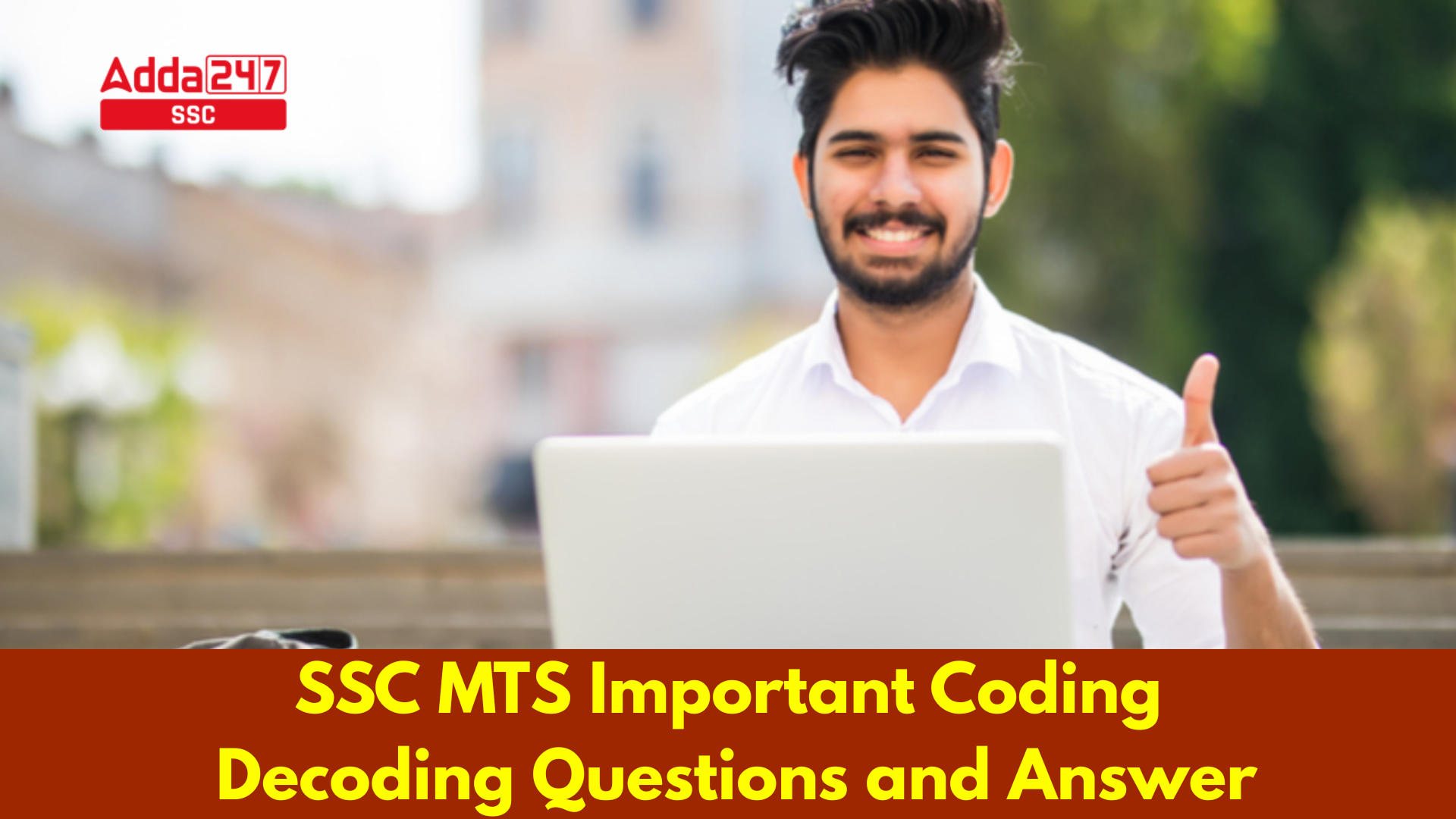
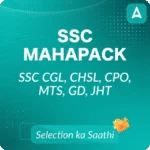


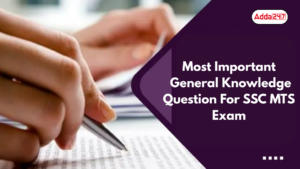 Most Important General Knowledge Questio...
Most Important General Knowledge Questio...
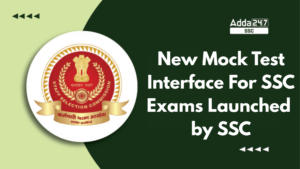 New Mock Test Interface For SSC Exams La...
New Mock Test Interface For SSC Exams La...
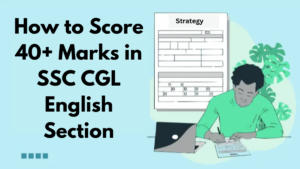 How to Score 40+ Marks in SSC CGL Englis...
How to Score 40+ Marks in SSC CGL Englis...
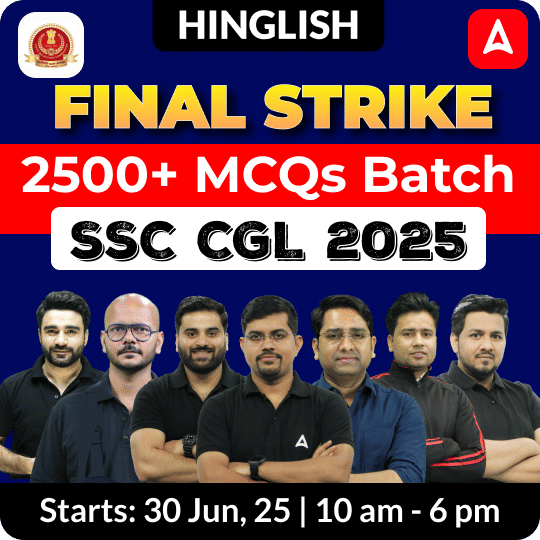
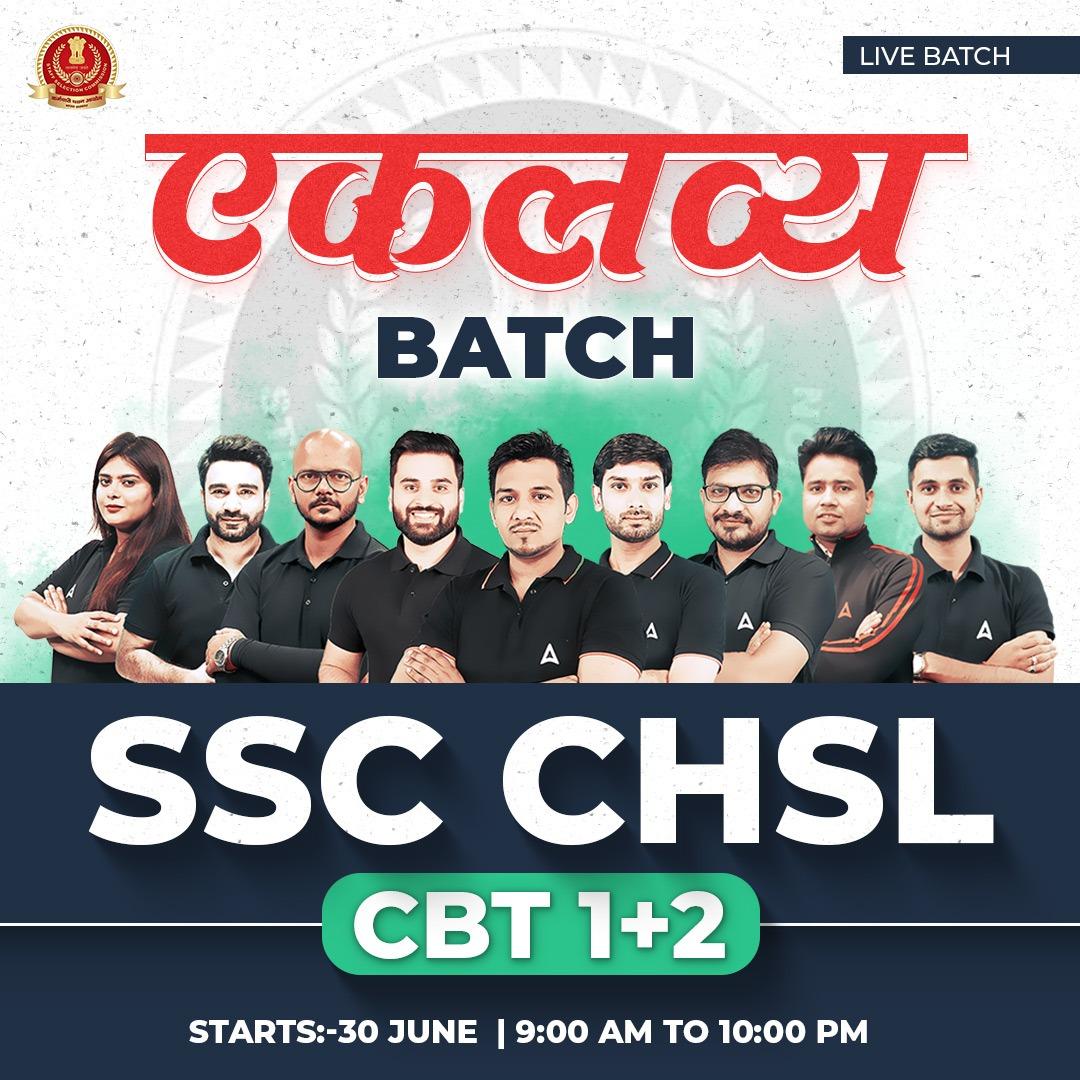
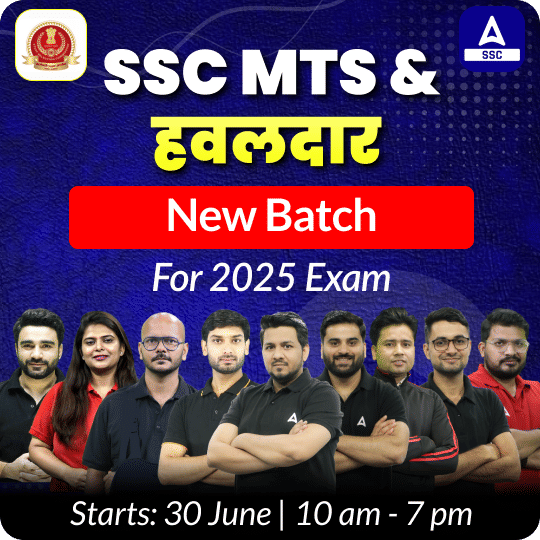
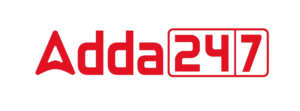 Adda247 Job portal has complete information about all Sarkari Jobs and Naukri Alerts, its latest recruitment notifications, from all state and national level jobs and their updates.
Adda247 Job portal has complete information about all Sarkari Jobs and Naukri Alerts, its latest recruitment notifications, from all state and national level jobs and their updates.